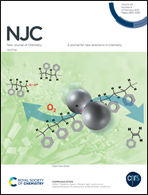Superior UV-light photocatalysts of nano-crystalline (Ni or Co) FeWO4: structure, optical characterization and synthesis by a microemulsion method†
Abstract
This study reports a microemulsion method to successfully prepare nanocrystalline (cobalt or nickel) iron tungstate powders (Nix or Cox)Fe1−XWO4 (where X = 0 and 0.5). The powders were calcined at a temperature of 600 °C for 6 hours and optimized at pH 10. The change in the crystal structure, microstructure, crystallite size, optical properties, and specific surface area were investigated using XRD, FTIR, TEM, and surface area analysis (SBET). The optical, electrical, and magnetic properties were explained using UV-vis, PL, the Hall-effect, and VSM. The findings indicate that the tungstate powders had average particle sizes of around 12–18 nm. The mean pore diameter was 4.5–6.3 nm, and the specific SBET of the material obtained was approximately 13.72–17.69 m2 g−1. The photocatalytic activity of methylene blue (MB) dye decolorization has been investigated. In MB dye photodegradation, the as-prepared NiFeWO4 powders demonstrated substantial improvement (100% after 60 min). The obtained results reveal NiFeWO4 powders with uncomplicated production, high UV-light photocatalytic activity, and recyclable properties.



 Please wait while we load your content...
Please wait while we load your content...